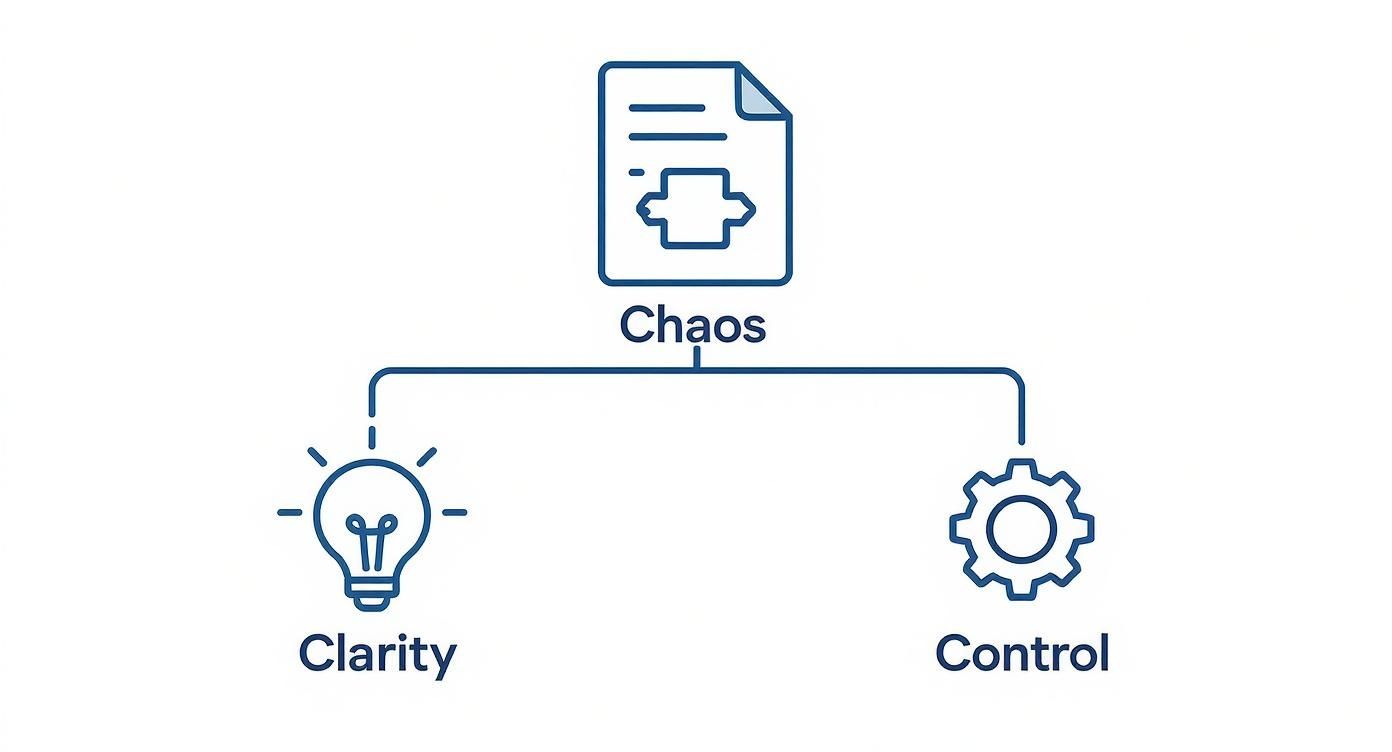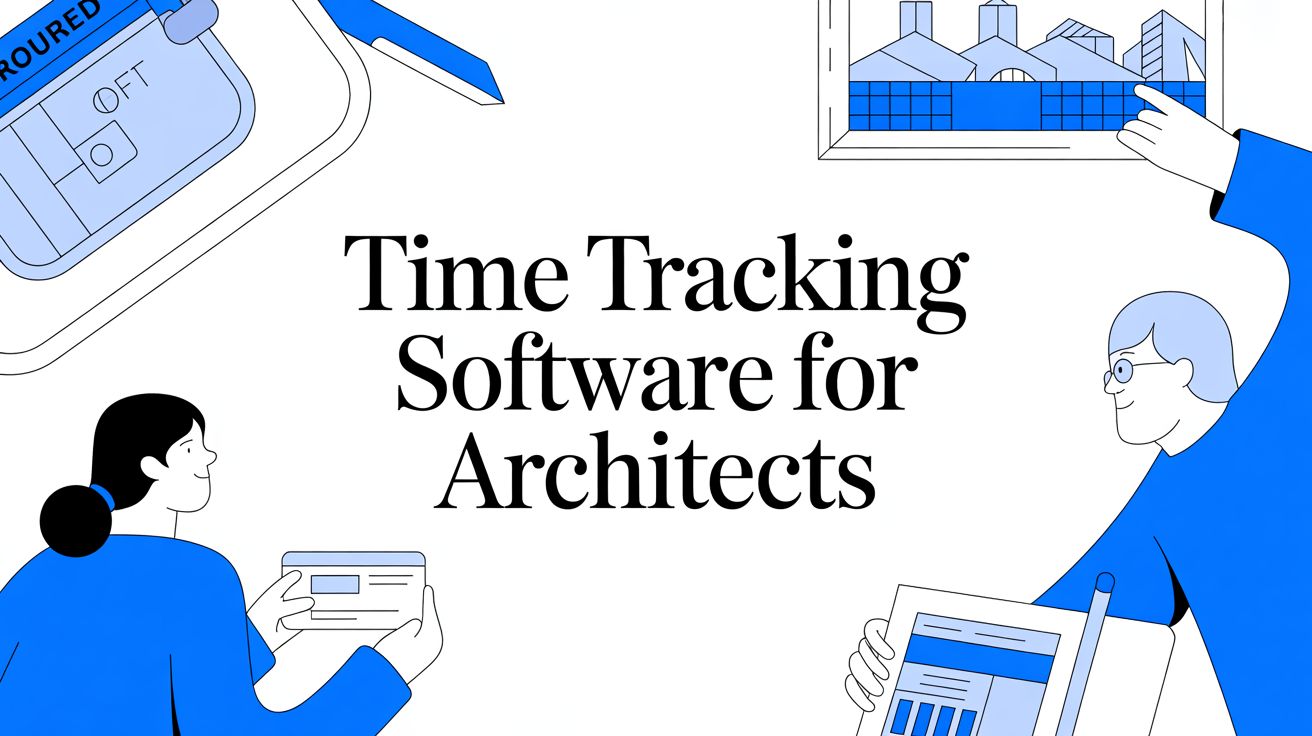- Why Manual Timesheets No Longer Build Success
- The Hidden Costs of Old Habits
- Key Features for a Modern Architectural Firm
- Project and Phase-Specific Tracking
- Seamless Software Integrations
- Core Features Checklist for Architectural Time Tracking Software
- How Smart Time Data Drives Profitability
- Crafting More Precise Fee Proposals
- Spotting Unprofitable Projects Early
- Balancing Workloads and Preventing Burnout
- Choosing the Right Software for Your Firm
- Define Your Firm’s Unique Blueprint
- Use Free Trials as Your Proving Ground
- Prioritize Scalability for Future Growth
- Implementing Time Tracking Without Team Friction
- Start with a Small Pilot Program
- Frame It as a Team Benefit
- What’s Next for Time Management in Architecture?
- AI and Automation are on the Horizon
- Frequently Asked Questions
- Will My Team Feel Micromanaged?
- How Much Does Architect-Specific Software Cost?
- Can This Software Integrate With Other Tools?
For decades, architectural firms got by with spreadsheets and manual timesheets. But let’s be honest, those old habits just don’t cut it anymore. Modern time tracking software for architects isn’t just a minor upgrade; it’s a foundational shift. Think of it as moving from a hand-drawn sketch to a fully detailed BIM model—it brings a whole new level of clarity and precision to your operations.
Why Manual Timesheets No Longer Build Success
Juggling multiple architectural projects with a patchwork of spreadsheets is a recipe for chaos. One minute you’re deep in schematic design for a new community center, the next you’re on-site for a construction check-in at a residential build, and later you’re back at the office refining permit drawings for a commercial renovation. How can anyone accurately capture every billable minute across all those scattered phases?
For too many firms, the reality is a frantic scramble at the end of the month, piecing together fragmented time entries and chasing down timesheets. You’re left hoping the final numbers somehow reflect the true effort your team poured into the work. This manual grind isn’t just tedious; it’s a massive risk to your firm’s financial health, creating blind spots where profitability slowly erodes, one unbilled hour at a time.
The Hidden Costs of Old Habits
The trouble with manual tracking goes way beyond simple inconvenience. It hits your bottom line and your team’s efficiency in some pretty critical ways:
- Inaccurate Project Bidding: When you’re estimating fees for a new project based on fuzzy historical data, you’re basically guessing. For instance, if you don’t realize that permit approvals in your city are taking 30% longer than they did last year, you’ll underbid that phase every time. Underbid, and you crush your profit margins. Overbid, and you lose the project entirely.
- Revenue Leakage: Every unrecorded phone call with a client, quick sketch revision, or half-hour spent researching a new zoning code is lost revenue. These little moments add up fast, turning into substantial financial losses over a project’s lifecycle.
- Poor Resource Planning: Without a clear view of where your team’s time is really going, how can you effectively plan for the next project? It’s tough to know if your lead designer is stretched too thin or if a junior architect has the bandwidth to take on more modeling work, leading to burnout and missed deadlines.
The complexity of modern architectural projects demands a higher level of precision. Manual methods simply can’t provide the detailed information needed for accurate billing and efficient resource allocation across multiple simultaneous projects.
This is exactly why adopting a dedicated time tracking software for architects has become so crucial. It provides a clear, detailed picture of where time is spent, paving the way for accurate client billing and much smarter project management. According to a study mentioned on yaware.com, this transition empowers your firm to make proactive, data-driven decisions that protect both your creative vision and your financial stability.
To see how this works in practice, you can learn more about how modern time tracking features can support your firm’s specific goals.
Key Features for a Modern Architectural Firm
Picking the right time tracking software for an architectural firm feels a lot like selecting the perfect material for a new build. It needs to be functional, durable, and specifically suited to the unique demands of your projects. A generic timer from a one-size-fits-all app just won’t cut it.
Modern architectural practices need a toolkit designed for their distinct workflow. This means moving beyond basic clocks and into features that bring genuine clarity to incredibly complex projects. The right platform shifts you from chaotic manual tracking to a system of control and insight.

This is about more than just logging hours; it’s about transforming scattered data points into the organized intelligence you need to make smarter, more profitable decisions.
Project and Phase-Specific Tracking
At its core, any tool you consider must be able to track time not just by the overall project, but by specific architectural phases. The effort your team puts into ‘Schematic Design’ has a completely different value and cost structure than time spent on ‘Construction Administration’.
A powerful tool lets you create and assign custom phases for every single project. For instance, an architect can log 2.5 hours directly against the “Permit Drawings” phase of the “Downtown Library” project. That level of detail is non-negotiable for understanding which stages eat up the most resources.
This granularity is what allows you to craft much more accurate fee proposals for future work. Without it, you’re essentially flying blind.
Seamless Software Integrations
Your time tracker can’t be an isolated island of data. It absolutely has to connect with the other critical software your firm relies on every single day (or would ideally be WITHIN this other operational softare). This creates a cohesive digital ecosystem, saving countless hours of mind-numbing manual data entry and drastically reducing the risk of human error.
A key integration consideration is connections with tools like QuickBooks or Xero. Imagine turning all your approved billable hours for the month into client-ready invoices with just a few clicks. It’s a game-changer for speeding up your billing cycle.
The benefit of your time-tracking being within your project management system is that it will sync with your project management timelines, tasks and invoicing. For a deeper dive, check out our guide on project management for architects to see how these systems create a single source of truth.
Core Features Checklist for Architectural Time Tracking Software
| Feature Category | Must-Have Functionality | Why It’s Critical for Architects |
|---|---|---|
| Time Tracking | Project and Phase-level logging, timers, manual entry | Allows for granular cost analysis across all stages of a project, from schematic design to construction administration. |
| Billing & Invoicing | Billable vs. Non-billable tracking, customizable rates | Directly impacts profitability and ensures accurate, transparent client invoices that reflect the true work performed. |
| Integrations | Accounting (QuickBooks, Xero) & Project Management | Creates a connected workflow, eliminating double-entry and ensuring financial and project data are always in sync. |
| Reporting | Project budget vs. actuals, team utilization | Provides the data needed for accurate future proposals, resource planning, and understanding firm-wide profitability. |
While advanced features like expense tracking and resource scheduling are valuable, the items in this table represent the foundational toolkit every architectural firm needs to get started. Make sure any software you consider nails these basics before you look at the extras.
How Smart Time Data Drives Profitability
Accurate time tracking does way more than just fill out timesheets. It’s the very foundation of your firm’s financial health. When you stop guessing and start knowing exactly where every hour goes, that data transforms from a simple record into a powerful strategic asset. It’s the missing link that connects your team’s day-to-day work directly to your bottom line.
Think of it this way: trying to manage your firm’s finances without smart time data is like designing a building with incomplete blueprints. You might make some progress, but you’re constantly reacting to problems you never saw coming. With clear data, you can proactively build a more stable and profitable structure for your business.

This shift isn’t minor—it empowers you to make confident, data-driven decisions that are the bedrock of growth and stability.
Crafting More Precise Fee Proposals
One of the most immediate wins from detailed time tracking is the power to create surgically precise fee proposals. You can finally ditch the gut feelings or outdated project data and build your estimates on a solid foundation of historical fact.
For instance, your reports might reveal that the “Construction Documents” phase on your last three mid-sized commercial projects consistently ate up 25% more hours than you originally estimated. Armed with that knowledge, your next proposal can reflect the true effort required. This means you can quote a fee that protects your profit margins while still being fair to the client. This historical data is your firm’s most valuable asset for future planning.
Spotting Unprofitable Projects Early
Modern time tracking software for architects is like an early warning system for projects that are starting to go off the rails. Real-time dashboards and budget-versus-actual reports give you an immediate, crystal-clear view of a project’s financial health at any moment.
Imagine you’re halfway through a project and the time tracking report flags that the “Schematic Design” phase has already burned through 60% of its allocated budget. That’s a red flag you can act on right now. You can pull the project manager aside, reallocate resources, or start a conversation with the client about a change order before a small budget variance snowballs into a serious problem. You can learn more about monitoring your firm’s financial performance to turn these insights into concrete strategies.
By leveraging detailed time reports, firms can justify every single billable hour with complete transparency. This builds incredible client trust and significantly speeds up the invoicing and payment cycle.
Balancing Workloads and Preventing Burnout
Profitability isn’t just about dollars and cents; it’s also about your team’s well-being and efficiency. Time data gives managers the insights they need to balance workloads effectively, making sure the right talent is on the right task without anyone heading for burnout.
If you notice one architect is consistently logging over 50 hours a week on complex BIM modeling while another has some breathing room, you can make an informed decision to redistribute tasks. This move doesn’t just support your team’s health—it ensures projects keep moving forward efficiently. It’s about using data to manage your most important resource—your people—with care and precision.
Choosing the Right Software for Your Firm
Wading through dozens of options for time tracking software for architects can feel like sketching a masterpiece with a crayon. The friendly advice? Start by looking inward—understand your workflow, team size and day-to-day challenges before you even fire up a demo.
It’s a lot like laying out a project brief. You wouldn’t pick paint colors before finalizing the design. Ask yourself: How many people need seats today and in two years? What’s your monthly cost ceiling per user? Which apps—say, QuickBooks or Revit—must play nicely with your new tool? Answering those questions first acts like a sieve, letting you zero in on tools that actually fit your studio.
Define Your Firm’s Unique Blueprint
Small studios often crave an uncluttered interface and a solid mobile app for on-site logging. Larger practices usually demand deeper analytics, resource-allocation controls and layered permissions to keep 50-person teams humming.
Build a simple checklist of non-negotiables:
- Team Size: Current headcount and realistic growth in two years
- Budget Per User: Monthly spend you can support without flinching
- Key Integrations: Accounting, PM or design tools that must talk to your tracker
- Top Three Goals: Are you trying to fix inaccurate invoicing? Plug resource planning gaps? Or solve project-profit blind spots?
This blueprint keeps you honest—and stops you from chasing flashy extras that solve nothing critical.
Use Free Trials as Your Proving Ground
Most reputable trackers offer at least a 14-day trial. Resist the urge to poke at every button. Instead, treat it like a mini pilot project to see how it feels in the real world:
- Set up one or two of your live projects in the trial environment.
- Ask two teammates to log their real hours for a week, just as they would normally.
- At the end of the week, run a report and compare the entries to your existing timesheets.
“Only by living in the software for a few days will you know if it eases your team’s routine—or trips them up at every click.”
On top of that, you’ll want to keep an eye on where the market is headed. The time tracking software sector hit $3.35 billion in 2024 and is forecast to swell to $3.9 billion in 2025, driven by firms chasing tighter project controls and smarter reporting.
Prioritize Scalability for Future Growth
The perfect tool for your three-person atelier should still feel like home when you’re fifteen strong. Look for:
- Tiered pricing plans that don’t skyrocket when you add seats
- Modular features you can switch on as needs evolve
- A clear upgrade path that avoids painful data migrations
A scalable time tracking software for architects isn’t just a short-term fix—it’s an anchor for your practice’s next chapter.
Implementing Time Tracking Without Team Friction
Rolling out new software in your firm can feel a bit like adding a new wall to a finished building. If you don’t do it just right, it can be seriously disruptive. The idea behind time tracking software for architects isn’t to create cracks in your team culture, but to add a supportive structural element. And the only way to do that is to put your people first.
When you handle it with care, the implementation becomes a positive step for everyone. The conversation should never be about watching the clock; it’s about gaining clarity. You need to frame this new tool as a way to ensure workloads are fair, project plans are more accurate, and the firm’s financial health is protected—which, of course, benefits the whole team.

This simple shift in approach changes the entire dynamic. It moves the focus from oversight to insight, making your team partners in the process, not just subjects of it.
Start with a Small Pilot Program
Instead of a big, firm-wide rollout on day one, start small. Pick one or two tech-savvy team members or a single, self-contained project to run a pilot program. This creates a low-stakes environment where you can work out the kinks and get some honest feedback before everyone dives in.
For instance, you could ask your pilot group to track their time on a specific project for just two weeks. Afterward, sit down with them for coffee. Talk about what worked and what felt clumsy. Was it a pain to log time from a construction site? Did the project phase categories actually make sense in practice? This kind of hands-on testing gives you invaluable, real-world insights that a slick software demo never will.
“A successful rollout is less about the software itself and more about how it’s introduced. When your team sees it as a tool to help them win, not a tool to watch them work, adoption becomes natural and enthusiastic.”
This initial feedback loop is gold. It lets you refine your process, create genuinely helpful documentation based on questions your own team asked, and build a core group of internal champions who can guide their colleagues when you do the full launch.
Frame It as a Team Benefit
The way you introduce this software will completely define how it’s received. Your team needs to understand the “why” behind the change, and that “why” has to be about collective benefits, not just management metrics.
Here’s how you can frame that conversation:
- For Fairer Workloads: “This tool will give us a clear picture of project demands, helping us balance assignments and catch potential burnout before it happens.”
- For Smarter Bidding: “When we know exactly how long each phase takes, we can create much more accurate proposals. That means we win the right projects and can make sure we’re properly staffed to deliver.”
- For Client Transparency: “Detailed time entries let us provide clear, justifiable invoices. This builds trust with clients and, frankly, helps us get paid faster.”
By focusing on these shared goals, you position the time tracking software as what it should be: a resource for smarter, more sustainable work. It stops being a chore and becomes a tool for professional growth and project success, which is exactly the kind of buy-in you need for a smooth rollout.
What’s Next for Time Management in Architecture?
The world of project management technology is always moving, and the tools available to architectural firms are getting a whole lot smarter. We’re well past the era of clunky timers and manual timesheets. The future is software that actively thinks with you, giving you deeper insights with far less effort.
These aren’t just small tweaks to how you track hours; they’re about giving your firm a strategic edge. The whole point is to shift time tracking software for architects from being a simple record-keeping chore into a predictive, analytical partner in your business.
AI and Automation are on the Horizon
Imagine software that chews through your past project data to flag potential timeline overruns on a new design—before you’ve even locked in the proposal. This isn’t science fiction. Artificial intelligence is starting to make this happen, offering pretty sophisticated resource forecasting and risk assessment based on your firm’s own project history.
These emerging trends point to a future where the tech handles the grunt work of tracking, freeing up your team to do what they do best: designing incredible spaces.
It’s no surprise the global market for project time tracking software is booming. This growth is fueled by the demand for more powerful, cloud-based tools that can keep up with hybrid teams and increasingly complex projects. The integration of AI and automation is front and center, helping firms everywhere get more done with less friction. You can read more about these market trends on archivemarketresearch.com.
Frequently Asked Questions
You’ve still got questions? Good. That’s completely normal. Bringing a new tool into your firm is a big decision, and it’s smart to get all the facts straight before you jump in. Here are some straightforward answers to the questions we hear most often from architecture firms just like yours.
Will My Team Feel Micromanaged?
This is a big one, and it’s a totally valid concern. Nobody wants to feel like Big Brother is watching over their shoulder.
The key is how you frame it. This isn’t about surveillance; it’s about transparency and smarter planning. When you introduce time tracking software for architects, emphasize how the data protects the team from burnout by making future project estimates more realistic. It’s about making sure everyone’s hard work is accurately captured and billed for, not about policing their every move.
When the focus shifts from oversight to insight, teams are almost always on board.
How Much Does Architect-Specific Software Cost?
Costs can be all over the map, but most modern tools have settled on a per-user, per-month subscription. You’ll typically see this range from $7 to $90+ per person depending on whether the time-tracking is taking place in isolation or if it’s part of a larger suite of tools.
Many platforms also offer a free version with the basics covered, which can be a great starting point for solo practitioners or small studios. We always, always recommend taking a free trial for a spin. There’s no better way to see how the software actually fits into your daily workflow before you commit.
Can This Software Integrate With Other Tools?
It absolutely should. In fact, if it doesn’t, that’s a major red flag. Solid integration is a hallmark of any good piece of business software today.
Look for a platform that plays nicely with the tools you already rely on, like QuickBooks or Xero for your accounting.
A well-integrated system gets rid of tedious double-entry, slashes the risk of errors, and creates a single source of truth for your project financials and timelines. The number of administrative hours this saves is staggering.
Ready to see how all this actually works in a real firm?
Drum brings every piece of your workflow together, from the first proposal to the final invoice. It's the clarity you need to build a more successful practice.
Start your free 14-day trial and discover a better way to run your studio.


